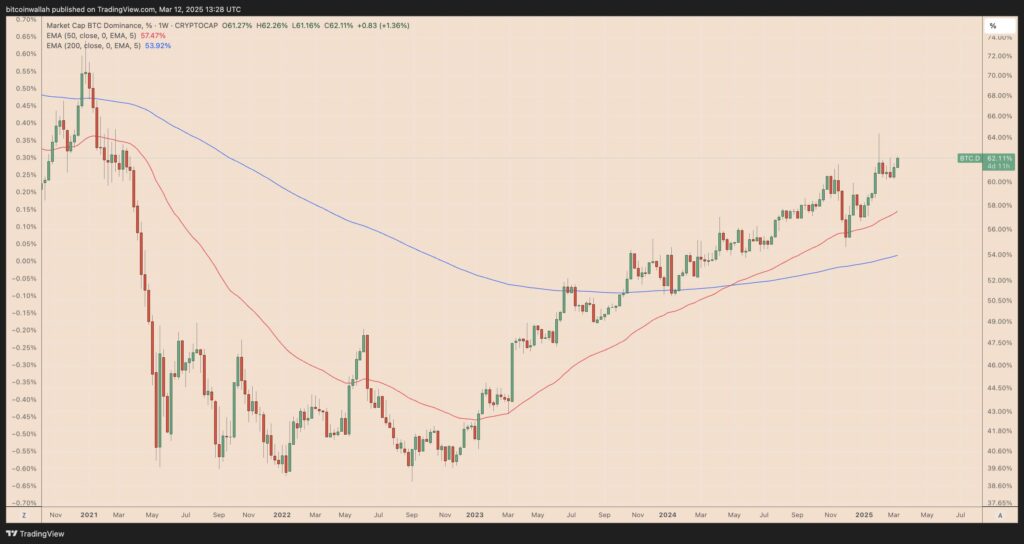In a significant shift within the cryptocurrency landscape, Ethereum’s native token, Ether (ETH), has recently dipped to its lowest levels against Bitcoin (BTC) since May 2020. This decline has prompted analysts to express concerns about further decreases in the weeks ahead, highlighting a persistent downtrend that has seen Ether plunge over 85% since hitting a record high in June 2017. As of March 13, the ETH/BTC trading pair fell by more than 1.50%, reaching [openai_gpt model=”gpt-4o-mini” prompt=”You are a news reporter covering the cryptocurrency industry. Given the article description, provide an introductory overview of the news in an informative style. AVOID using overly technical terms or details! DO NOT offer recomendations to buy or sell any assets! Analyze from a fact-based perspective and bring in additional research when claims are made. Write this overview with creativity and flair, ensuring it reads like a human-written text and incorporates keywords in a natural way for SEO optimization. Generate HTML-formatted content using only
, and
tags. Exclude headings and other HTML tags. DO NOT include a ‘Conclusion’ section! Here is the product description: ‘Ethereum’s native token, Ether (ETH), has dropped to its multi-year lows against Bitcoin (BTC), prompting analysts to predict further declines in the coming weeks.Falling knife warning furthers sell-off risks On March 13, ETH/BTC—a pair that tracks Ether’s strength against Bitcoin—dropped by over 1.50% to reach $0.022, its lowest level since May 2020.ETH’s descent is part of its multi-year downtrend that started when it established a record high of $0.156 in June 2017. Since then, it has plunged by more than 85%, underscoring Ether’s growing weakness against Bitcoin.Meanwhile, on the two-week ETH/BTC chart, the relative strength index (RSI), a momentum indicator used to measure whether an asset is overbought or oversold, has fallen to a record low of 23.32.ETH/BTC two-week price chart. Source: TradingViewTypically, when RSI drops below 30, it signals oversold conditions, potentially leading to a price rebound. However, in Ethereum’s case, RSI has continued to plunge even lower even two months after becoming oversold, suggesting that ETH’s downtrend is still accelerating rather than stabilizing.Crypto analyst Alessandro Ottaviani has described the situation as a “falling knife” scenario—a term used to describe an asset that is experiencing a rapid and steep decline, often discouraging buyers from stepping in too soon. A falling knife implies that attempting to catch the asset at a perceived low could lead to further losses if the downtrend persists.For Ethereum to signal a potential reversal, traders will be watching for RSI stabilization and reclaim of key resistance levels. That ideally begins with a rebound from the 0.022 BTC level, which had limited ETH/BTC’s downside attempts in December 2020, leading to a 300% rally.ETH/BTC weekly price chart. Source: TradingViewShould a rebound happen, the ETH/BTC pair can rally toward its 0.382 Fibonacci retracement line at around 0.038 BTC, aligning with the 50-week exponential moving average (50-week EMA; the red wave).Until then, the technical outlook suggests that ETH/BTC could remain trapped in its falling knife trajectory, with the next potential downside targets at historical support levels inside the 0.020-0.016 BTC range.ETH/BTC two-week price chart. Source: TradingViewThe lowest point of this range is approximately 30% below the current price levels.ETH/BTC fundamentals support a bearish outlookEther’s prospects of declining further against Bitcoin are rooted in factors beyond technical analysis. For instance, Ethereum currently faces strong competition from rival layer-1 blockchains, namely Solana (SOL). Related: ‘The worst thing that happened to Ethereum’ — Bitcoin up 160% since the MergeVanEck noted that Solana’s decentralized exchange volume has surpassed Ethereum’s even during a steep dropoff in memecoin trading activity. Meanwhile, Solana’s volume has risen consistently in recent months, which coincides with a decline in Ethereum’s volumes.Solana vs. Ethereum DEX volumes. Source: VanEckFurthermore, the launch of spot Bitcoin ETFs has fundamentally altered the traditional crypto market cycle that used to benefit Ethereum and other altcoins.Historically, after Bitcoin surged post-halving, capital rotated into altcoins, triggering an “altseason” where ETH and other assets outperformed BTC. However, the $129 billion inflows into Bitcoin ETFs in 2024 have disrupted this cycle, draining liquidity from the broader altcoin market—including Ethereum.Bitcoin Dominance Index weekly price chart. Source: TradingViewAnother factor is Ethereum-specific selling pressure. The recent Bybit hack reportedly led to substantial ETH liquidations, with some of that value laundered via decentralized platforms like Thorchain. This absorbed sell-off may still be rippling through the market, depressing ETH’s relative value.This article does not contain investment advice or recommendations. Every investment and trading move involves risk, and readers should conduct their own research when making a decision.'”].022, raising alarm bells among market watchers.
The current market scenario evokes what crypto analyst Alessandro Ottaviani refers to as a “falling knife” situation—a term used to illustrate the risks associated with attempting to invest in an asset undergoing a rapid decline. Despite traditional indicators suggesting oversold conditions, as evidenced by the relative strength index (RSI) dropping to a historic low of 23.32, Ethereum has yet to stabilize and show signs of recovery.
“For Ethereum to signal a potential reversal, traders will be watching for RSI stabilization and reclaim of key resistance levels,” noted market analysts.
One potential support level to watch is the [openai_gpt model=”gpt-4o-mini” prompt=”You are a news reporter covering the cryptocurrency industry. Given the article description, provide an introductory overview of the news in an informative style. AVOID using overly technical terms or details! DO NOT offer recomendations to buy or sell any assets! Analyze from a fact-based perspective and bring in additional research when claims are made. Write this overview with creativity and flair, ensuring it reads like a human-written text and incorporates keywords in a natural way for SEO optimization. Generate HTML-formatted content using only
, and
tags. Exclude headings and other HTML tags. DO NOT include a ‘Conclusion’ section! Here is the product description: ‘Ethereum’s native token, Ether (ETH), has dropped to its multi-year lows against Bitcoin (BTC), prompting analysts to predict further declines in the coming weeks.Falling knife warning furthers sell-off risks On March 13, ETH/BTC—a pair that tracks Ether’s strength against Bitcoin—dropped by over 1.50% to reach $0.022, its lowest level since May 2020.ETH’s descent is part of its multi-year downtrend that started when it established a record high of $0.156 in June 2017. Since then, it has plunged by more than 85%, underscoring Ether’s growing weakness against Bitcoin.Meanwhile, on the two-week ETH/BTC chart, the relative strength index (RSI), a momentum indicator used to measure whether an asset is overbought or oversold, has fallen to a record low of 23.32.ETH/BTC two-week price chart. Source: TradingViewTypically, when RSI drops below 30, it signals oversold conditions, potentially leading to a price rebound. However, in Ethereum’s case, RSI has continued to plunge even lower even two months after becoming oversold, suggesting that ETH’s downtrend is still accelerating rather than stabilizing.Crypto analyst Alessandro Ottaviani has described the situation as a “falling knife” scenario—a term used to describe an asset that is experiencing a rapid and steep decline, often discouraging buyers from stepping in too soon. A falling knife implies that attempting to catch the asset at a perceived low could lead to further losses if the downtrend persists.For Ethereum to signal a potential reversal, traders will be watching for RSI stabilization and reclaim of key resistance levels. That ideally begins with a rebound from the 0.022 BTC level, which had limited ETH/BTC’s downside attempts in December 2020, leading to a 300% rally.ETH/BTC weekly price chart. Source: TradingViewShould a rebound happen, the ETH/BTC pair can rally toward its 0.382 Fibonacci retracement line at around 0.038 BTC, aligning with the 50-week exponential moving average (50-week EMA; the red wave).Until then, the technical outlook suggests that ETH/BTC could remain trapped in its falling knife trajectory, with the next potential downside targets at historical support levels inside the 0.020-0.016 BTC range.ETH/BTC two-week price chart. Source: TradingViewThe lowest point of this range is approximately 30% below the current price levels.ETH/BTC fundamentals support a bearish outlookEther’s prospects of declining further against Bitcoin are rooted in factors beyond technical analysis. For instance, Ethereum currently faces strong competition from rival layer-1 blockchains, namely Solana (SOL). Related: ‘The worst thing that happened to Ethereum’ — Bitcoin up 160% since the MergeVanEck noted that Solana’s decentralized exchange volume has surpassed Ethereum’s even during a steep dropoff in memecoin trading activity. Meanwhile, Solana’s volume has risen consistently in recent months, which coincides with a decline in Ethereum’s volumes.Solana vs. Ethereum DEX volumes. Source: VanEckFurthermore, the launch of spot Bitcoin ETFs has fundamentally altered the traditional crypto market cycle that used to benefit Ethereum and other altcoins.Historically, after Bitcoin surged post-halving, capital rotated into altcoins, triggering an “altseason” where ETH and other assets outperformed BTC. However, the $129 billion inflows into Bitcoin ETFs in 2024 have disrupted this cycle, draining liquidity from the broader altcoin market—including Ethereum.Bitcoin Dominance Index weekly price chart. Source: TradingViewAnother factor is Ethereum-specific selling pressure. The recent Bybit hack reportedly led to substantial ETH liquidations, with some of that value laundered via decentralized platforms like Thorchain. This absorbed sell-off may still be rippling through the market, depressing ETH’s relative value.This article does not contain investment advice or recommendations. Every investment and trading move involves risk, and readers should conduct their own research when making a decision.'”].022 mark, which previously limited ETH/BTC’s declines in late 2020. If a rebound occurs, experts foresee a possible rally towards the 0.038 BTC level. However, without signs of recovery, forecasts suggest ETH could descend further, hitting historical support levels between 0.020 and 0.016 BTC, translating to a decrease of around 30% from current levels.
The bearish outlook for Ether is not purely technical. Observations from VanEck highlight the increased competition Ethereum faces from alternative blockchains, particularly Solana, which has outperformed ETH in decentralized exchange volumes. This shift in market dynamics is compounded by the recent introduction of spot Bitcoin ETFs, which have altered traditional capital rotations that often favored altcoins like Ethereum.
“Historically, after Bitcoin surged, capital rotated into altcoins, but the influx into Bitcoin ETFs has drained liquidity from the broader altcoin market,” VanEck explained.
Adding to the pressure on Ethereum is a wave of selling triggered by recent incidents, such as the Bybit hack, which has resulted in significant ETH liquidations and continued to impact the token’s relative value amidst overall market turmoil.
Ethereum’s Struggles Against Bitcoin
As Ethereum’s native token, Ether (ETH), experiences significant declines, several key points emerge that could impact readers involved in cryptocurrency investing:
- ETH’s Multi-Year Low: Ether has dropped to [openai_gpt model=”gpt-4o-mini” prompt=”Based on the article content, generate a list of key points in an HTML format using Bold, UL/OL. Focus solely on the most important aspects, and describe how they might be related or impact the readers life if at all. Begin with a title using
HTML tag in this format: ‘
Title Goes Here
‘. Use only
,
,
,
- , and
tags. DO NOT include a ‘Conclusion’ section! Here is the topic description: ‘Ethereum’s native token, Ether (ETH), has dropped to its multi-year lows against Bitcoin (BTC), prompting analysts to predict further declines in the coming weeks.Falling knife warning furthers sell-off risks On March 13, ETH/BTC—a pair that tracks Ether’s strength against Bitcoin—dropped by over 1.50% to reach $0.022, its lowest level since May 2020.ETH’s descent is part of its multi-year downtrend that started when it established a record high of $0.156 in June 2017. Since then, it has plunged by more than 85%, underscoring Ether’s growing weakness against Bitcoin.Meanwhile, on the two-week ETH/BTC chart, the relative strength index (RSI), a momentum indicator used to measure whether an asset is overbought or oversold, has fallen to a record low of 23.32.ETH/BTC two-week price chart. Source: TradingViewTypically, when RSI drops below 30, it signals oversold conditions, potentially leading to a price rebound. However, in Ethereum’s case, RSI has continued to plunge even lower even two months after becoming oversold, suggesting that ETH’s downtrend is still accelerating rather than stabilizing.Crypto analyst Alessandro Ottaviani has described the situation as a “falling knife” scenario—a term used to describe an asset that is experiencing a rapid and steep decline, often discouraging buyers from stepping in too soon. A falling knife implies that attempting to catch the asset at a perceived low could lead to further losses if the downtrend persists.For Ethereum to signal a potential reversal, traders will be watching for RSI stabilization and reclaim of key resistance levels. That ideally begins with a rebound from the 0.022 BTC level, which had limited ETH/BTC’s downside attempts in December 2020, leading to a 300% rally.ETH/BTC weekly price chart. Source: TradingViewShould a rebound happen, the ETH/BTC pair can rally toward its 0.382 Fibonacci retracement line at around 0.038 BTC, aligning with the 50-week exponential moving average (50-week EMA; the red wave).Until then, the technical outlook suggests that ETH/BTC could remain trapped in its falling knife trajectory, with the next potential downside targets at historical support levels inside the 0.020-0.016 BTC range.ETH/BTC two-week price chart. Source: TradingViewThe lowest point of this range is approximately 30% below the current price levels.ETH/BTC fundamentals support a bearish outlookEther’s prospects of declining further against Bitcoin are rooted in factors beyond technical analysis. For instance, Ethereum currently faces strong competition from rival layer-1 blockchains, namely Solana (SOL). Related: ‘The worst thing that happened to Ethereum’ — Bitcoin up 160% since the MergeVanEck noted that Solana’s decentralized exchange volume has surpassed Ethereum’s even during a steep dropoff in memecoin trading activity. Meanwhile, Solana’s volume has risen consistently in recent months, which coincides with a decline in Ethereum’s volumes.Solana vs. Ethereum DEX volumes. Source: VanEckFurthermore, the launch of spot Bitcoin ETFs has fundamentally altered the traditional crypto market cycle that used to benefit Ethereum and other altcoins.Historically, after Bitcoin surged post-halving, capital rotated into altcoins, triggering an “altseason” where ETH and other assets outperformed BTC. However, the $129 billion inflows into Bitcoin ETFs in 2024 have disrupted this cycle, draining liquidity from the broader altcoin market—including Ethereum.Bitcoin Dominance Index weekly price chart. Source: TradingViewAnother factor is Ethereum-specific selling pressure. The recent Bybit hack reportedly led to substantial ETH liquidations, with some of that value laundered via decentralized platforms like Thorchain. This absorbed sell-off may still be rippling through the market, depressing ETH’s relative value.This article does not contain investment advice or recommendations. Every investment and trading move involves risk, and readers should conduct their own research when making a decision.'”].022 against Bitcoin, marking its lowest level since May 2020.
- Long-term Downtrend: Since peaking at [openai_gpt model=”gpt-4o-mini” prompt=”Based on the article content, generate a list of key points in an HTML format using Bold, UL/OL. Focus solely on the most important aspects, and describe how they might be related or impact the readers life if at all. Begin with a title using
HTML tag in this format: ‘
Title Goes Here
‘. Use only
,
,
,
- , and
tags. DO NOT include a ‘Conclusion’ section! Here is the topic description: ‘Ethereum’s native token, Ether (ETH), has dropped to its multi-year lows against Bitcoin (BTC), prompting analysts to predict further declines in the coming weeks.Falling knife warning furthers sell-off risks On March 13, ETH/BTC—a pair that tracks Ether’s strength against Bitcoin—dropped by over 1.50% to reach $0.022, its lowest level since May 2020.ETH’s descent is part of its multi-year downtrend that started when it established a record high of $0.156 in June 2017. Since then, it has plunged by more than 85%, underscoring Ether’s growing weakness against Bitcoin.Meanwhile, on the two-week ETH/BTC chart, the relative strength index (RSI), a momentum indicator used to measure whether an asset is overbought or oversold, has fallen to a record low of 23.32.ETH/BTC two-week price chart. Source: TradingViewTypically, when RSI drops below 30, it signals oversold conditions, potentially leading to a price rebound. However, in Ethereum’s case, RSI has continued to plunge even lower even two months after becoming oversold, suggesting that ETH’s downtrend is still accelerating rather than stabilizing.Crypto analyst Alessandro Ottaviani has described the situation as a “falling knife” scenario—a term used to describe an asset that is experiencing a rapid and steep decline, often discouraging buyers from stepping in too soon. A falling knife implies that attempting to catch the asset at a perceived low could lead to further losses if the downtrend persists.For Ethereum to signal a potential reversal, traders will be watching for RSI stabilization and reclaim of key resistance levels. That ideally begins with a rebound from the 0.022 BTC level, which had limited ETH/BTC’s downside attempts in December 2020, leading to a 300% rally.ETH/BTC weekly price chart. Source: TradingViewShould a rebound happen, the ETH/BTC pair can rally toward its 0.382 Fibonacci retracement line at around 0.038 BTC, aligning with the 50-week exponential moving average (50-week EMA; the red wave).Until then, the technical outlook suggests that ETH/BTC could remain trapped in its falling knife trajectory, with the next potential downside targets at historical support levels inside the 0.020-0.016 BTC range.ETH/BTC two-week price chart. Source: TradingViewThe lowest point of this range is approximately 30% below the current price levels.ETH/BTC fundamentals support a bearish outlookEther’s prospects of declining further against Bitcoin are rooted in factors beyond technical analysis. For instance, Ethereum currently faces strong competition from rival layer-1 blockchains, namely Solana (SOL). Related: ‘The worst thing that happened to Ethereum’ — Bitcoin up 160% since the MergeVanEck noted that Solana’s decentralized exchange volume has surpassed Ethereum’s even during a steep dropoff in memecoin trading activity. Meanwhile, Solana’s volume has risen consistently in recent months, which coincides with a decline in Ethereum’s volumes.Solana vs. Ethereum DEX volumes. Source: VanEckFurthermore, the launch of spot Bitcoin ETFs has fundamentally altered the traditional crypto market cycle that used to benefit Ethereum and other altcoins.Historically, after Bitcoin surged post-halving, capital rotated into altcoins, triggering an “altseason” where ETH and other assets outperformed BTC. However, the $129 billion inflows into Bitcoin ETFs in 2024 have disrupted this cycle, draining liquidity from the broader altcoin market—including Ethereum.Bitcoin Dominance Index weekly price chart. Source: TradingViewAnother factor is Ethereum-specific selling pressure. The recent Bybit hack reportedly led to substantial ETH liquidations, with some of that value laundered via decentralized platforms like Thorchain. This absorbed sell-off may still be rippling through the market, depressing ETH’s relative value.This article does not contain investment advice or recommendations. Every investment and trading move involves risk, and readers should conduct their own research when making a decision.'”].156 in June 2017, Ether has declined by over 85%, indicating its ongoing weakness in comparison to Bitcoin.
- RSI Indicator at Record Low: The relative strength index (RSI) for the ETH/BTC pair has fallen to 23.32, signaling potential oversold conditions, yet it continues to decline.
- Falling Knife Scenario: Analysts point to a “falling knife” situation, where trying to buy at low prices may result in further losses as the downtrend intensifies.
- Need for Reversal Indicators: Traders are focusing on key resistance levels and RSI stabilization for signs of a potential reversal. A rebound from [openai_gpt model=”gpt-4o-mini” prompt=”Based on the article content, generate a list of key points in an HTML format using Bold, UL/OL. Focus solely on the most important aspects, and describe how they might be related or impact the readers life if at all. Begin with a title using
HTML tag in this format: ‘
Title Goes Here
‘. Use only
,
,
,
- , and
tags. DO NOT include a ‘Conclusion’ section! Here is the topic description: ‘Ethereum’s native token, Ether (ETH), has dropped to its multi-year lows against Bitcoin (BTC), prompting analysts to predict further declines in the coming weeks.Falling knife warning furthers sell-off risks On March 13, ETH/BTC—a pair that tracks Ether’s strength against Bitcoin—dropped by over 1.50% to reach $0.022, its lowest level since May 2020.ETH’s descent is part of its multi-year downtrend that started when it established a record high of $0.156 in June 2017. Since then, it has plunged by more than 85%, underscoring Ether’s growing weakness against Bitcoin.Meanwhile, on the two-week ETH/BTC chart, the relative strength index (RSI), a momentum indicator used to measure whether an asset is overbought or oversold, has fallen to a record low of 23.32.ETH/BTC two-week price chart. Source: TradingViewTypically, when RSI drops below 30, it signals oversold conditions, potentially leading to a price rebound. However, in Ethereum’s case, RSI has continued to plunge even lower even two months after becoming oversold, suggesting that ETH’s downtrend is still accelerating rather than stabilizing.Crypto analyst Alessandro Ottaviani has described the situation as a “falling knife” scenario—a term used to describe an asset that is experiencing a rapid and steep decline, often discouraging buyers from stepping in too soon. A falling knife implies that attempting to catch the asset at a perceived low could lead to further losses if the downtrend persists.For Ethereum to signal a potential reversal, traders will be watching for RSI stabilization and reclaim of key resistance levels. That ideally begins with a rebound from the 0.022 BTC level, which had limited ETH/BTC’s downside attempts in December 2020, leading to a 300% rally.ETH/BTC weekly price chart. Source: TradingViewShould a rebound happen, the ETH/BTC pair can rally toward its 0.382 Fibonacci retracement line at around 0.038 BTC, aligning with the 50-week exponential moving average (50-week EMA; the red wave).Until then, the technical outlook suggests that ETH/BTC could remain trapped in its falling knife trajectory, with the next potential downside targets at historical support levels inside the 0.020-0.016 BTC range.ETH/BTC two-week price chart. Source: TradingViewThe lowest point of this range is approximately 30% below the current price levels.ETH/BTC fundamentals support a bearish outlookEther’s prospects of declining further against Bitcoin are rooted in factors beyond technical analysis. For instance, Ethereum currently faces strong competition from rival layer-1 blockchains, namely Solana (SOL). Related: ‘The worst thing that happened to Ethereum’ — Bitcoin up 160% since the MergeVanEck noted that Solana’s decentralized exchange volume has surpassed Ethereum’s even during a steep dropoff in memecoin trading activity. Meanwhile, Solana’s volume has risen consistently in recent months, which coincides with a decline in Ethereum’s volumes.Solana vs. Ethereum DEX volumes. Source: VanEckFurthermore, the launch of spot Bitcoin ETFs has fundamentally altered the traditional crypto market cycle that used to benefit Ethereum and other altcoins.Historically, after Bitcoin surged post-halving, capital rotated into altcoins, triggering an “altseason” where ETH and other assets outperformed BTC. However, the $129 billion inflows into Bitcoin ETFs in 2024 have disrupted this cycle, draining liquidity from the broader altcoin market—including Ethereum.Bitcoin Dominance Index weekly price chart. Source: TradingViewAnother factor is Ethereum-specific selling pressure. The recent Bybit hack reportedly led to substantial ETH liquidations, with some of that value laundered via decentralized platforms like Thorchain. This absorbed sell-off may still be rippling through the market, depressing ETH’s relative value.This article does not contain investment advice or recommendations. Every investment and trading move involves risk, and readers should conduct their own research when making a decision.'”].022 could spark a rally towards [openai_gpt model=”gpt-4o-mini” prompt=”Based on the article content, generate a list of key points in an HTML format using Bold, UL/OL. Focus solely on the most important aspects, and describe how they might be related or impact the readers life if at all. Begin with a title using
HTML tag in this format: ‘
Title Goes Here
‘. Use only
,
,
,
- , and
tags. DO NOT include a ‘Conclusion’ section! Here is the topic description: ‘Ethereum’s native token, Ether (ETH), has dropped to its multi-year lows against Bitcoin (BTC), prompting analysts to predict further declines in the coming weeks.Falling knife warning furthers sell-off risks On March 13, ETH/BTC—a pair that tracks Ether’s strength against Bitcoin—dropped by over 1.50% to reach $0.022, its lowest level since May 2020.ETH’s descent is part of its multi-year downtrend that started when it established a record high of $0.156 in June 2017. Since then, it has plunged by more than 85%, underscoring Ether’s growing weakness against Bitcoin.Meanwhile, on the two-week ETH/BTC chart, the relative strength index (RSI), a momentum indicator used to measure whether an asset is overbought or oversold, has fallen to a record low of 23.32.ETH/BTC two-week price chart. Source: TradingViewTypically, when RSI drops below 30, it signals oversold conditions, potentially leading to a price rebound. However, in Ethereum’s case, RSI has continued to plunge even lower even two months after becoming oversold, suggesting that ETH’s downtrend is still accelerating rather than stabilizing.Crypto analyst Alessandro Ottaviani has described the situation as a “falling knife” scenario—a term used to describe an asset that is experiencing a rapid and steep decline, often discouraging buyers from stepping in too soon. A falling knife implies that attempting to catch the asset at a perceived low could lead to further losses if the downtrend persists.For Ethereum to signal a potential reversal, traders will be watching for RSI stabilization and reclaim of key resistance levels. That ideally begins with a rebound from the 0.022 BTC level, which had limited ETH/BTC’s downside attempts in December 2020, leading to a 300% rally.ETH/BTC weekly price chart. Source: TradingViewShould a rebound happen, the ETH/BTC pair can rally toward its 0.382 Fibonacci retracement line at around 0.038 BTC, aligning with the 50-week exponential moving average (50-week EMA; the red wave).Until then, the technical outlook suggests that ETH/BTC could remain trapped in its falling knife trajectory, with the next potential downside targets at historical support levels inside the 0.020-0.016 BTC range.ETH/BTC two-week price chart. Source: TradingViewThe lowest point of this range is approximately 30% below the current price levels.ETH/BTC fundamentals support a bearish outlookEther’s prospects of declining further against Bitcoin are rooted in factors beyond technical analysis. For instance, Ethereum currently faces strong competition from rival layer-1 blockchains, namely Solana (SOL). Related: ‘The worst thing that happened to Ethereum’ — Bitcoin up 160% since the MergeVanEck noted that Solana’s decentralized exchange volume has surpassed Ethereum’s even during a steep dropoff in memecoin trading activity. Meanwhile, Solana’s volume has risen consistently in recent months, which coincides with a decline in Ethereum’s volumes.Solana vs. Ethereum DEX volumes. Source: VanEckFurthermore, the launch of spot Bitcoin ETFs has fundamentally altered the traditional crypto market cycle that used to benefit Ethereum and other altcoins.Historically, after Bitcoin surged post-halving, capital rotated into altcoins, triggering an “altseason” where ETH and other assets outperformed BTC. However, the $129 billion inflows into Bitcoin ETFs in 2024 have disrupted this cycle, draining liquidity from the broader altcoin market—including Ethereum.Bitcoin Dominance Index weekly price chart. Source: TradingViewAnother factor is Ethereum-specific selling pressure. The recent Bybit hack reportedly led to substantial ETH liquidations, with some of that value laundered via decentralized platforms like Thorchain. This absorbed sell-off may still be rippling through the market, depressing ETH’s relative value.This article does not contain investment advice or recommendations. Every investment and trading move involves risk, and readers should conduct their own research when making a decision.'”].038.
- Potential Further Decline: Current technical analysis suggests ETH/BTC could drop further, with targets in the 0.020-0.016 BTC range—close to 30% lower than current levels.
- Competitive Pressure from Solana: Ethereum faces increased competition from Solana and other layer-1 blockchains, which have reported higher trading volumes, diminishing Ethereum’s market presence.
- Impact of Bitcoin ETFs: The launch of Bitcoin ETFs has redirected capital away from altcoins, further straining Ethereum’s value and positioning in the market.
- Market Response to Hacks: Liquidations resulting from recent hacks within the Ethereum ecosystem are contributing to downward pressure, affecting its comparative value against Bitcoin.
Readers should consider these factors as they navigate the complex landscape of cryptocurrency investing. Understanding the dynamics between Ethereum and Bitcoin may influence personal investment decisions.
Ethereum’s Struggles: A Comparative Analysis Against Rivals
Ethereum’s native token, Ether (ETH), appears to be teetering on the edge of a downward spiral, with its value declining dramatically against Bitcoin (BTC). The latest data indicates that ETH has dropped to levels not seen in several years, raising red flags for investors and analysts alike. This scenario draws a fascinating comparison with other rising blockchain platforms, particularly Solana (SOL), which is carving out its own space in the crypto ecosystem.
Competitive Advantages: One of the main advantages Solana holds over Ethereum is its emerging position as the go-to platform for decentralized exchange (DEX) trading. Recent reports show that Solana’s DEX volume has begun to surpass that of Ethereum, even amid a slump in memecoins. This shift could signal a fundamental change in preference among traders, as Solana benefits from faster transaction speeds and lower fees. With the recent influx of capital into Bitcoin ETFs also influencing market dynamics, liquidity previously allocated to Ethereum is now gravitating towards Solana and other layer-1 solutions.
Moreover, the market’s mood is determining which assets hold investor interest. With Bitcoin achieving milestones that traditionally spark a rotation into altcoins, Ethereum’s failure to keep pace with its own narrative could undermine its historical role as a leader in the altcoin season. This distinctive positioning of Solana, combined with its consistency in attracting liquidity, provides it an edge that Ethereum seems to be losing.
Competitive Disadvantages: On the flip side, Ethereum’s established network and ecosystem are difficult to overlook. The sheer volume of decentralized apps (dApps) operating on Ethereum continues to dwarf that of Solana, offering a range of functionalities from finance to gaming that keep users engaged. Furthermore, Ethereum is undergoing significant upgrades, such as the transition to Ethereum 2.0, which aims to address scalability issues and environmental concerns. This potential evolution could revitalize ETH’s market position and reassure long-term investors of its viability.
However, the current market sentiment, amplified by the term “falling knife”—describing an asset experiencing rapid declines—could raise alarm among potential ETH buyers. Those looking to enter the market may hesitate in fear of catching the proverbial falling knife, therefore contributing to further downward pressure in the interim.
Target Audience: The implications of this scenario could particularly impact investors holding diversified crypto portfolios, especially those weighted in Ethereum. For long-term holders, this may prompt a reassessment of their strategies or a move toward less risk-averse assets like Solana. Conversely, traders focused on technical analysis might see the oversold conditions as an opportunity to capitalize on a reversal, provided they carefully monitor resistance levels. Ultimately, Ethereum’s dynamics present both a competitive advantage in established infrastructure and a significant disadvantage amid rising market threats, creating a complex environment for both new entrants and seasoned investors.

















